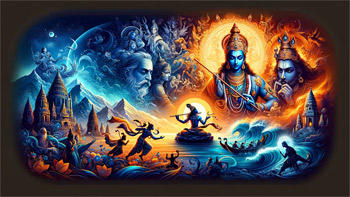Hindu mythology, a cornerstone of one of the world's oldest living religions, Hinduism, is a complex and fascinating subject. This mythology is not just a mere collection of stories but a profound narrative of the universe, human existence, and the divine. It encompasses a wide array of gods, goddesses, heroes, and epic tales that form the bedrock of Hindu cultural and religious practices, deeply influencing art, music, literature, and daily life in Hindu societies.
At its core, Hindu mythology serves as a medium to convey profound spiritual and moral truths, often through symbolic narratives. These stories have been passed down through generations orally and later written in Sanskrit in ancient texts like the Vedas, the Upanishads, the Mahabharata, the Ramayana, and the Puranas. Each of these texts plays a significant role in shaping the religious consciousness of Hindu believers.
The Pantheon of Hindu Gods and Goddesses
In Hindu mythology, there is a vast array of deities, each symbolizing different aspects of life and the universe. The concept of Brahman, the ultimate reality, manifests in various forms. Among the most prominent gods are Brahma, the creator; Vishnu, the preserver; and Shiva, the destroyer. These three form the Hindu Trinity, or Trimurti, each responsible for maintaining the balance and order of the cosmos.
Goddesses in Hindu mythology are equally powerful and revered. Goddesses like Saraswati, goddess of wisdom and arts; Lakshmi, goddess of wealth and purity; and Parvati, the mother goddess, are deeply venerated. Each deity in Hindu mythology has a unique story, symbolizing various virtues and aspects of existence, and is worshiped with specific rituals and prayers.
Epic Tales: The Mahabharata and The Ramayana
Two epic poems, the Mahabharata and the Ramayana, are the most renowned in Hindu mythology. The Mahabharata, one of the longest epic poems in the world, narrates the story of the Kurukshetra War and the fates of the Kaurava and the Pandava princes. It includes the Bhagavad Gita, a sacred text that contains a conversation between Prince Arjuna and the god Krishna, who serves as his charioteer.
The Ramayana, attributed to the sage Valmiki, recounts the life of Prince Rama, his wife Sita, and his loyal brother Lakshmana. The narrative covers their exile, Sita's abduction by the demon king Ravana, and Rama's victory over evil. These epics are not just stories but are integral to the moral and ethical framework of Hindu culture, imparting lessons on duty, righteousness, and the complexities of human life.
Symbolism and Morals in Hindu Mythology
Hindu mythology is rich in symbolism. Deities taking various avatars (incarnations) signify the divine's intervention in worldly affairs to restore cosmic order. The stories are multi-layered, often with allegorical meanings, teaching moral and ethical lessons important for maintaining social order and personal spiritual growth.
For instance, the churning of the ocean of milk, a famous story, symbolizes the eternal quest for Amrita, the nectar of immortality. This narrative conveys the idea of achieving balance between the forces of good and evil and the importance of cooperation and perseverance in the pursuit of life's goals.
Festivals and Celebrations in Hindu Mythology
Hindu festivals and celebrations are deeply rooted in mythological stories. Major festivals like Diwali (the Festival of Lights) and Holi (the Festival of Colors) have their origins in these ancient tales. Diwali celebrates the return of Rama to Ayodhya after defeating Ravana, symbolizing the victory of light over darkness. Holi is associated with the divine play of Lord Krishna, celebrating joy, love, and the arrival of spring.
These festivals are not only times of religious observance but also of communal joy and unity. They play a crucial role in preserving the mythological traditions and imparting their moral and spiritual lessons to younger generations.
Hindu Mythology's Influence on Art and Culture
The influence of Hindu mythology extends far beyond religious practices; it pervades the art, music, dance, and theater of India and beyond. Classical dance forms like Bharatanatyam, Kathakali, and Odissi depict stories from these myths. In literature, these stories have inspired countless works, from ancient poetry to contemporary novels.
Moreover, the themes and characters of Hindu mythology have found resonance in popular culture, including films, television series, and even comic books, making these ancient tales accessible and relevant to the modern world.
In essence, Hindu mythology offers a window into the spiritual and cultural heritage of Hinduism. It's a vivid tapestry of stories that continue to fascinate, educate, and inspire, bridging the past and the present, the divine and the human, across generations and geographies.
